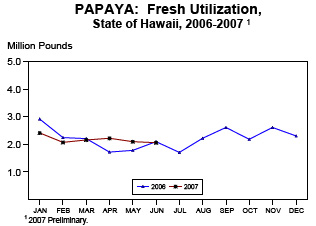Here is the PDF file for the *Hawaii Crop Weather* (crop progress and condition) Report for the week ending *July 29, 2007*
Please visit the website for more information: http://www.nass.usda.gov/hi/
USDA NASS Hawaii Field Office
1421 South King Street
Honolulu, HI 96814-2512
1-800- 804-9514
Agricultural Highlights
Fruits
Vegetables
Head Cabbage
Active harvest is in progress in the Waimea fields. Head sizes ranged from medium to small in the Waimea area of the Big Island. Heavy irrigation maintained normal crop progress. Insect damage was generally light. The Volcano crop was in fair condition. Weather conditions have not been favorable for optimum growth. Maui?s crop continued to show slow but steady progress under hot growing conditions. Producers increased irrigation for their fields, but overall the crop appears to be tolerating the heat well. Insect pressure for the most part has been low to moderate throughout the major growing area with only a few reports of slightly increased pressure being noted. Damage was under control. Losses to the crop were mainly due wildlife feeding as the dry surrounding areas have not been sufficient to support the natural wildlife in the area. Birds, deer, and some domestic animals have entered fields in search of food and water. Plantings have continued, and production is expected to be steady at current levels. Some fields were abandoned on Oahu to control the increasing pressure from the Diamondback moth infestation.
Dry Onions
Maui?s crop continued to show steady progress even though the hot growing conditions have been very challenging for the crop. Average yields were hovering at lower levels for most fields mainly due to smaller bulb size. There have also been increased reports of losses due to wildlife feeding and damage in the fields. Some of these fields will be abandoned. The onion crop was in generally fair to marginally fair condition.
Tomatoes
Young vines in the Big Island?s Waimea area made good progress. The crop was in generally good condition. Vines in Glenwood and Kona greenhouses were in fair to good condition. Young vines had good fruit set.
Other Crops
Coffee
Field in the Kona Districts of the Big Island benefited from convective showers. Orchards on Kauai were in good condition as the berries size up with heavy irrigation applications. Reservoirs were replenished with rains at the upper elevations and water resources are expected to be at adequate levels to bring the crop to harvest. Insect pressure was low.
Ginger Root
Young ginger crop continued to make good progress due to the favorable weather conditions in eastern sections of the County of Hawaii. Sunny and warm weather throughout most of the week and adequate soil moisture benefited root development.
 JUNE FRESH PAPAYA OUTPUT LOWER
JUNE FRESH PAPAYA OUTPUT LOWER To restore Molokai’s contaminated soil, University of Hawaii researchers Alton Arakaki and Qing Li, as well as retired Molokai farmer Lonnie Williams, are rooting for a technique called phytoremediation, which consists of growing plants that can naturally accumulate chemicals from soil.
To restore Molokai’s contaminated soil, University of Hawaii researchers Alton Arakaki and Qing Li, as well as retired Molokai farmer Lonnie Williams, are rooting for a technique called phytoremediation, which consists of growing plants that can naturally accumulate chemicals from soil.